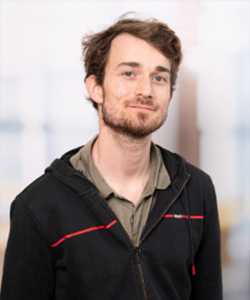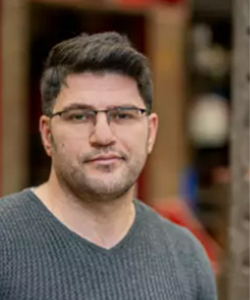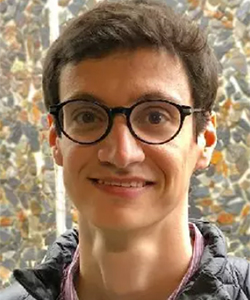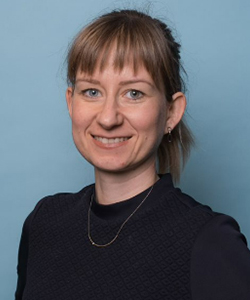Eight leading researchers receive Vidi-grant
NWO has awarded 102 researchers a Vidi grant in total 86,7 million euros. Eight promising TU Delft researchers from the domains Exact and Natural Sciences (ENS), Social Sciences and Humanities (SSH) and Applied and Technical Sciences (ATS) have been awarded. This Vidi grant up to 850,000 euros will enables the laureates to develop an innovative line of research over the next five years and further expand their own research group.
In the ENS domain, four Vidi’s were awarded to:
Quantum spin networks: All together is better than loosely connected
Christian Andersen, QuTech/Applied Sciences (QuTech/AS)
Quantum technologies promise to deliver great impact for the society but it is still an open question how to reach the best quantum devices. A key challenge is how to connect many quantum bits. Think of quantum bits as puzzle pieces. Individually, they hold potential, but when connected in a tight network, their combined abilities are significantly enhanced. This project aims at merging the best of two worlds in quantum computing into a tightly-knit network. I will combine the smallness of quantum dots with the efficiency of superconducting quantum bits to unlock a new approach to quantum computing.
More information
DNActuate: fundamentals of DNA nano-motions for molecular diagnostics
Sabina Caneva, Mechanical Engineering (ME)
DNA and proteins are fantastic examples of molecular machines. Researchers will develop a new biophysical platform to image and control the dynamics and mechanics of biomolecular processes at the single-molecule level. Combining ultra-flat, biocompatible 2D material surfaces with DNA nanotechnology, they will use fluorescence microscopy techniques to study how molecules move, interact and function. They will use the fundamental knowledge gained to develop new biosensors capable of detecting circulating tumour DNA. This will enable regular monitoring of cancer progression.
More information
Personal page
DELAY: the Dynamic Equilibrium of water in clays
Anne-Catherine Dieudonné, Civil Engineering and Geosciences (CEG)
The mechanisms responsible for the time-dependent behaviour of clays are poorly understood. While they are thought to involve the redistribution of water within the pore structure, they have never been systematically characterised, and their controls on the material behaviour have never been studied. The researchers will gain new fundamental insights into the dynamics of water-mineral interactions, and the effects on the material response, and will develop a new predictive model for clays based on the new insights. The project will lead to improved technical confidence in the feasibility and safety of geological disposal of radioactive waste in clay formations.
Optimization on curved spaces
Richard Kraaij, Electrical Engineering, Mathematics and Computer Science (EEMC)
Finding the fastest path to fly from Amsterdam to San Francisco leads you over Greenland. On the world map this looks like a curved path, a consequence of the Earth being a sphere.
To efficiently solve dynamic optimization problems in various fields, whether it is in physics or economics, it is therefore important to first find what is the curvature underlying the problem you are trying to solve. Using curvature-based methods will help to find efficient solution methods.
In this proposal we develop a mathematical framework to solve optimization problems where one has to account for curvature.
In the SSH domain, one Vidi was awarded to:
InCommon: How do we want to live together in the 21st century? Darinka Czischke, Architecture and the Built Environment (AE)
How do we want to live in the 21st century? Society changes fast, but housing is still organised according to traditional family models. However, alternative housing forms based on sharing and collectivity are questioning this paradigm. These ‘collaborative living’ forms seek to make housing more affordable, reduce environmental impact, and fight loneliness through stronger social connections. To what extent are more people willing to live like this? InCommon investigates what motivates different types of people to live in collaborative housing. This knowledge will offer a novel conceptualisation of ‘home’ and a new way to define and measure housing preferences.
In the ATS domain, three Vidi’s were awarded to:
Materials also need sleep - Next generation of High-performance and Sustainable Composite Materials
Mohammad Fotouhi, Civil Engineering and Geosciences (CEG)
Composites are truly the materials of the future. Their use is rising exponentially, continuing to replace or augment traditional materials. A key example is the construction of new large aircraft such as the Airbus A350. Despite this progress, they are brittle and can fail catastrophically. In addition, they get fatigued.
Can we add ductility and increase the lifetime of composites? Inspired by nature's hibernation more ductile and long-lasting composites are designed. This also allows for mixing cheap and expensive materials, reducing the cost without compromising their performance.
More information
Faculty news release
DigiOcean4Solar: a Digital Ocean environment for floating Solar farm assessment
Oriol Colomés Gené, Civil Engineering and Geosciences (CEG)
Floating solar technology offers a promising solution to global energy needs. However, floating solar farm design and assessment face complex challenges due to their unique wave-wind-structure interactions. DigiOcean4Solar will pioneer a digital ocean environment that can address these challenges. The new advanced digital framework will enable fast and reliable simulations, taking into account the complex multiscale and multiphysics nature of the problem. By enabling robust optimal designs and assessment of possible environmental impacts, DigiOcean4Solar will pave the way for a sustainable scale-up of floating solar energy and contribute to future offshore developments.
Neuro-Mark: Tensor-based network biomarker discovery
Borbála Hunyadi, Electrical Engineering, Mathematics and Computer Science (EEMC)
We orient ourselves in the physical world using maps. This project builds a map to navigate the realm of neurological disorders. First, I will develop computer-based methods to describe the properties of brain networks of individual patients. Using these properties – known as biomarkers - I will locate them on the map. On one hand, the biomarkers give important insights to mechanisms underlying neurological disorders. On the other hand, the map will help clinicians make accurate diagnosis and optimize treatment planning.
Personal page
Faculty news release
NWO Talent programme
The NWO Talent Programme gives researchers the freedom to pursue their own research based on creativity and passion. The NWO Talent Programme encourages innovation and curiosity. Curiosity-driven research contributes to and prepares us for tomorrow’s society. That is why NWO focuses on diversity in terms of researchers, domains and backgrounds. Together with the Veni and Vici grants, Vidi is part of the NWO Talent Programme.
NWO selects researchers based on the academic quality and innovative character of the research proposal, scientific and/or societal impact of the proposed project and the quality of the researcher.
Please read the press release of NWO.







